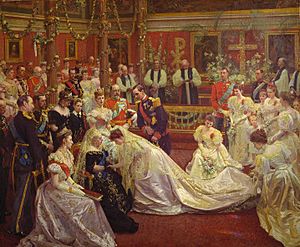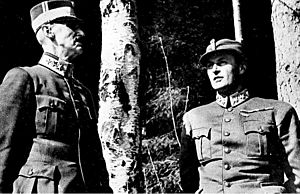Haakon VII of Norway facts for kids
Quick facts for kids Haakon VII |
|||||
|---|---|---|---|---|---|
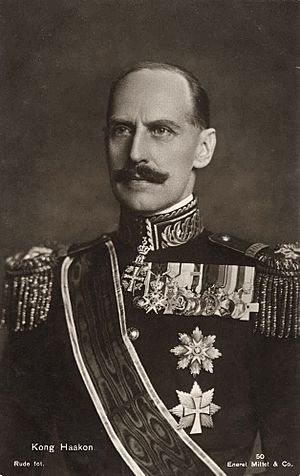
Photograph by Ernest Rude, 1930
|
|||||
| King of Norway | |||||
| Reign | 18 November 1905 − 21 September 1957 | ||||
| Coronation | 22 June 1906 Nidaros Cathedral, Trondheim, Norway |
||||
| Predecessor | Oscar II | ||||
| Successor | Olav V | ||||
| Prime Ministers |
See list
|
||||
| Born | Prince Carl of Denmark 3 August 1872 Charlottenlund Palace, Copenhagen, Denmark |
||||
| Died | 21 September 1957 (aged 85) Royal Palace, Oslo, Norway |
||||
| Burial | 1 October 1957 Akershus Castle, Oslo, Norway |
||||
| Spouse | |||||
| Issue | Olav V of Norway | ||||
|
|||||
| House | Glücksburg | ||||
| Father | Frederick VIII of Denmark | ||||
| Mother | Louise of Sweden | ||||
| Signature |  |
||||
Haakon VII (born Prince Carl of Denmark; 3 August 1872 – 21 September 1957) was the King of Norway. He reigned from November 1905 until his death in September 1957.
He was born in Copenhagen, Denmark. His father was the future Frederick VIII of Denmark, and his mother was Louise of Sweden. Prince Carl trained at the Royal Danish Naval Academy. He served in the Royal Danish Navy for many years.
In 1905, Norway separated from Sweden. Prince Carl was then offered the Norwegian crown. After a special vote by the people, he accepted the offer. He was formally chosen as King of Norway by the Storting (Norway's parliament). He chose the Old Norse name Haakon. He became Haakon VII, the first independent Norwegian king since 1387.
As king, Haakon became very popular with the Norwegian people. Norway's constitution gives the King a lot of power. However, Haakon mostly played a symbolic role. He rarely got involved in politics. His son and grandson continued this tradition.
In April 1940, Nazi Germany invaded Norway. Haakon refused to accept German demands. They wanted him to make their puppet government legal. He said he would rather give up his throne than do that. He refused to step down even when he went into exile in Great Britain. He helped unite the Norwegian people in their fight against the invasion. This resistance continued during the five-year occupation in World War II. He returned to Norway in June 1945 after Germany was defeated.
He became King of Norway while his grandfather, Christian IX of Denmark, was still king in Denmark. His father and older brother later became kings of Denmark. Haakon died at age 85 in September 1957. He had reigned for almost 52 years. His only son, Olav V, became the next king.
Contents
Haakon VII's Early Life
Birth and Family Background
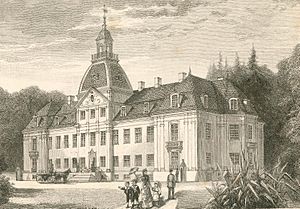
Prince Carl was born on 3 August 1872. This happened at his parents' home, Charlottenlund Palace. It is located north of Copenhagen. His grandfather, King Christian IX, was ruling Denmark at the time. Carl was the second son of Crown Prince Frederick of Denmark. His mother was Louise of Sweden.
His father was the oldest son of King Christian IX. His mother was the only daughter of King Charles XV of Sweden. Charles XV was also king of Norway as Charles IV. When Carl was born, he was third in line to the Danish throne. He was behind his father and older brother. He was not expected to become king.
Prince Carl was baptized at Charlottenlund Palace on 7 September 1872. He was given many names: Christian Frederik Carl Georg Valdemar Axel. He was known as Prince Carl. This name honored his maternal grandfather, the King of Sweden-Norway.
Prince Carl belonged to the Glücksburg branch of the House of Oldenburg. This family had been the Danish royal family since 1448. Between 1536 and 1814, they also ruled Norway. Norway was then part of the Kingdom of Denmark-Norway. The family came from northern Germany. Many of his ancestors had been kings of Norway.
Growing Up and School
Prince Carl grew up with his siblings in Copenhagen. They lived at their parents' city home, Frederick VIII's Palace. This palace is part of the Amalienborg Palace complex. They also spent time at their country home, Charlottenlund Palace. This home is by the coast north of the city.
Unlike other royal children at the time, their mother, Crown Princess Louise, raised them herself. She gave them a strict Christian upbringing. It focused on duty, care, and order.
Since Carl was a younger son, he was not expected to become king. He was third in line to the throne. He was behind his father and older brother, Prince Christian. Carl was less than two years younger than Christian. The two princes were educated together. They had a joint confirmation ceremony in 1887.
After his confirmation, Prince Carl began military training. He chose to join the Royal Danish Navy. He studied at the Royal Danish Naval Academy from 1889 to 1893. He graduated as a second lieutenant. In 1894, he became a first lieutenant. He served in the Royal Danish Navy until 1905.
Marriage and Family
On 22 July 1896, Prince Carl married his cousin, Princess Maud of Wales. The wedding took place at Buckingham Palace in London. Princess Maud was the youngest daughter of the Prince of Wales. He later became King Edward VII of the United Kingdom. Her mother was Princess Alexandra of Denmark. She was the oldest daughter of King Christian IX.
After the wedding, the couple lived in Copenhagen. Prince Carl continued his naval career there. Maud's father gave them Appleton House. This was a country home on the Sandringham Estate in England. It was for Maud's visits to England. Their only child, Prince Alexander, was born there. He was born on 2 July 1903. He later became Crown Prince Olav and then King Olav V of Norway.
Becoming King of Norway
How He Became King
In 1905, the Union between Sweden and Norway ended. A Norwegian government committee looked for a new king. They considered princes from different European royal families. Prince Carl became the top choice. This was mainly because he was related to earlier independent Norwegian kings.
He also had a son, which meant there was an heir to the throne. His wife, Princess Maud, was part of the British Royal Family. Many saw this as a good thing for the new independent Norway.
Carl was a democrat. He knew Norway was still deciding if it wanted a king or a republic. He said he would only accept the crown if the Norwegian people voted for it. He wanted a referendum (a public vote) to show their choice.
The referendum happened. Most Norwegians, 79 percent, voted to keep a monarchy. On 18 November 1905, the Storting (parliament) officially offered Prince Carl the throne. Carl accepted that evening. He immediately gained favor by taking the Old Norse name Haakon. This name had not been used by Norwegian kings for over 500 years. He replaced his great-uncle, Oscar II of Sweden, who had given up the Norwegian throne.
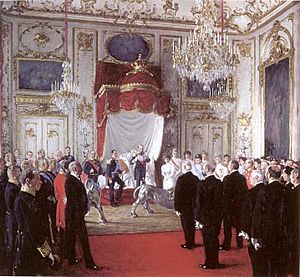
On 20 November, a large crowd gathered outside King Haakon and Queen Maud's home in Copenhagen. They cheered the royal couple. Later that day, King Christian IX of Denmark met with the Norwegian delegation. The delegation told him his grandson had been chosen as King of Norway. Christian IX agreed to Prince Carl's election. The head of the delegation, Carl Berner, shared greetings from the Norwegian people. He wished for good cooperation.
Arriving in Norway

On 23 November, the new royal family left Copenhagen. They sailed on the Danish royal yacht, the Dannebrog. They entered the Oslofjord. At Oscarsborg Fortress, they got on the Norwegian naval ship Heimdal.
After a three-day journey, they arrived in Kristiania (now Oslo). This was early on the morning of 25 November 1905. The Prime Minister of Norway Christian Michelsen met the king at the harbor.
Two days later, on 27 November, Haakon VII took his oath. He became Norway's first independent king in 518 years. Norway counts 18 November, the day he was elected, as the start of his reign.
The Coronation Ceremony
On 22 June 1906, King Haakon and Queen Maud were crowned. The ceremony took place in the Nidaros Cathedral in Trondheim. The Bishop of Trondheim, Vilhelm Andreas Wexelsen, performed the anointing. The coronation followed the constitution. However, many Norwegian leaders thought coronations were "undemocratic."
The coronation rule was removed from Norway's constitution in 1908. This was the last coronation of a Norwegian monarch. Before and after the coronation, the King and Queen traveled widely in Norway.
The King and Queen moved into the Royal Palace in Oslo. Haakon was the first monarch to live there permanently. The palace was renovated for two years before they moved in. After the coronation, the Norwegian people gave them the estate Kongesæteren in Oslo.
Early Years as King
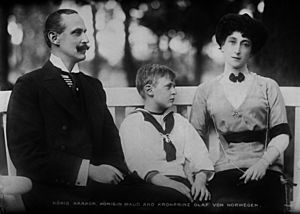
King Haakon became very popular with the Norwegian people. He traveled a lot throughout Norway. As king, Haakon worked to define the role of the monarchy. He wanted to balance Norway's informal way of life with the monarchy's formal duties.
Norway's constitution gives the King significant power. But in practice, the Government made most decisions. Haakon focused on non-political roles. He did not interfere in politics. His son and grandson continued this practice. His long reign gave him great moral authority. He became a symbol of the country's unity. The Norwegian explorer and Nobel Prize winner Fridtjof Nansen became a friend of the Royal Family.

In 1927, the Labour Party became the largest party in parliament. Early the next year, Norway's first Labour Party government took power. Many people thought the Labour Party was "revolutionary." The deputy prime minister advised against appointing Christopher Hornsrud as Prime Minister.
However, Haakon refused to ignore parliamentary rules. He asked Hornsrud to form a new government. He told his critics, "I am also the King of the Communists."
Crown Prince Olav married his cousin Princess Märtha of Sweden on 21 March 1929. She was the daughter of Haakon's sister Ingeborg. Olav and Märtha had three children: Ragnhild (born 1930), Astrid (born 1932), and Harald (born 1937). Harald later became king in 1991.
Queen Maud died unexpectedly in the United Kingdom on 20 November 1938.
Standing Strong During World War II
The German Invasion of Norway
Norway was invaded by Nazi Germany's forces on 9 April 1940. German ships tried to capture Oslo. But Oscarsborg Fortress fought back. The fortress sank the German cruiser Blücher. It also damaged the Lützow. Many German soldiers and officials were lost.
This stopped the Germans from taking Oslo at dawn. The delay, and quick action by the president of the Storting, C. J. Hambro, helped. The royal family, the government, and most parliament members escaped. They left the capital by special train.
The Storting met in Hamar that afternoon. But German troops advanced quickly. So the group moved to Elverum. The Storting then passed a resolution. It was called the Elverum Authorization. This gave the government full power to protect the country. This power would last until the Storting could meet again.
The next day, Curt Bräuer, the German Ambassador, met with Haakon. He demanded that Haakon accept Adolf Hitler's terms. These terms included ending all resistance. They also demanded appointing Vidkun Quisling as prime minister. Quisling was the leader of Norway's fascist party. He had already declared himself prime minister in Oslo. If Haakon had appointed him, it would have made the invasion seem legal.
Bräuer suggested Haakon follow the example of Denmark. Denmark's government and Haakon's brother, Christian X, had surrendered quickly. Bräuer threatened Norway with harsh consequences if it did not surrender. Haakon replied that he could not make the decision alone. He could only act on the government's advice.
In a meeting in Nybergsund, the King told his cabinet about the German ultimatum. Haakon said he could not appoint Quisling as prime minister. He knew neither the people nor the Storting trusted him. However, he said he would step down if the cabinet felt otherwise. He did not want to stand in the way of their decision.
Inspired by Haakon's strong stance, the government advised him not to appoint Quisling. They telephoned their refusal to Bräuer within hours. That night, NRK broadcast the government's rejection to the Norwegian people. The broadcast also announced that Norway would resist the invasion. They expressed confidence that Norwegians would support them.
After Norway was eventually taken over, Quisling created a one-party fascist state. He also recruited Norwegians to fight with the Germans. Only a small part of the population supported Quisling. Many joined the Norwegian resistance movement. After the war, Quisling was found guilty of treason and executed.
The Fight for Norway
On 11 April 1940, German bombers attacked Nybergsund. They tried to destroy Norway's king and government. The small town where the government was staying was destroyed. Neutral Sweden was only 16 kilometers away. But the Swedish government said it would arrest King Haakon if he crossed their border. Haakon never forgave this.
The Norwegian king and his ministers hid in the snowy woods. They escaped harm. They continued north through the mountains toward Molde on Norway's west coast. British forces in the area were losing ground to German bombing. So the King and his group boarded the British cruiser HMS Glasgow. They traveled another 1,000 kilometers north to Tromsø. A temporary capital was set up there on 1 May. Haakon and Crown Prince Olav lived in a forest cabin in Målselvdalen valley. They stayed there until they were evacuated to the United Kingdom.
The Allies controlled northern Norway until late May. But their situation in the Battle of France worsened. Germany was quickly taking over France. The Allied command decided to pull forces out of northern Norway. The Royal Family and Norwegian Government left Tromsø on 7 June. They sailed on HMS Devonshire with 461 passengers.
This evacuation was very costly for the Royal Navy. German warships Scharnhorst and Gneisenau attacked. They sank the aircraft carrier HMS Glorious and its escort ships. Devonshire did not report the enemy sighting. It could not break radio silence. No other British ship received the report. 1,519 British sailors and three warships were lost. Devonshire arrived safely in London. King Haakon and his cabinet set up a Norwegian government in exile in the British capital.
Leading from Exile
At first, King Haakon and Crown Prince Olav stayed at Buckingham Palace. But when the London Blitz started in September 1940, they moved. They went to Bowdown House in Berkshire. In March 1942, an airfield was built nearby. This made them move again. They moved to Foliejon Park near Windsor. They stayed there until Norway was freed.
The King's official home was the Norwegian Legation at 10 Palace Green. This became the headquarters for the Norwegian government in exile. Haakon attended weekly cabinet meetings there. He also worked on speeches. These speeches were broadcast regularly to Norway by the BBC World Service. These broadcasts helped Haakon become a strong national symbol. He represented the Norwegian resistance. Many broadcasts were made from Saint Olav's Norwegian Church. The Royal Family often attended services there.
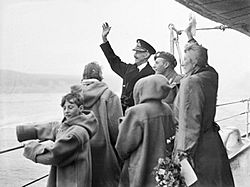
Meanwhile, Hitler had appointed Josef Terboven as Reichskommissar for Norway. Terboven tried to force the Storting to remove the King. The Storting refused. They said it was against their constitution. The Germans then threatened to put all Norwegian men of military age in concentration camps.
With this threat, the Storting's representatives in Oslo wrote to the King. On 27 June, they asked him to step down. The King politely refused. He replied that the Storting was acting under pressure. The King gave his answer on 3 July. He announced it on BBC radio on 8 July.
In September, the Germans tried again to force the Storting to remove Haakon. This also failed. Terboven then declared that the Royal Family had "lost their right to return." He also banned democratic political parties.
During Norway's five years under German control, many Norwegians wore special items. They wore clothes or jewelry made from coins with Haakon's "H7" monogram. This was a symbol of resistance against the German occupation. It also showed their support for their exiled King and Government. Just like in Denmark, people wore his brother's monogram. The King's monogram was also painted on surfaces. This showed their resistance to the occupation.
After the war, Haakon and the Norwegian royal family returned to Norway. They arrived on the cruiser HMS Norfolk. Cheering crowds greeted them in Oslo on 7 June 1945. This was exactly five years after they had left Tromsø. Crown Prince Olav had returned a few weeks earlier, on 13 May 1945.
After the War

After his return, Haakon did not continue his political role. He focused on his duties as head of state. In late summer 1945, he toured Norway. He wanted to see the war damage. He also wanted to comfort the people. Because of his role during the war, Haakon VII was highly respected. He was seen as the country's highest moral authority.
In 1947, the Norwegian people bought the royal yacht Norge for the King. They did this through public donations.
In 1952, he attended the funeral of his wife's nephew, King George VI. He openly wept at the service.
The King's granddaughter, Princess Ragnhild, married a businessman. His name was Erling Lorentzen. This happened on 15 May 1953. She was the first member of the new Norwegian royal family to marry someone who was not royal.
Haakon lived to see two of his great-grandchildren born. They were Haakon Lorentzen (born 23 August 1954) and Ingeborg Lorentzen (born 3 February 1957).
Crown Princess Märtha died of cancer on 5 April 1954.
King Haakon VII fell in his bathroom in July 1955. This happened at the Bygdøy Royal Estate. The fall, just before his 83rd birthday, broke his thighbone. He had to use a wheelchair. The King, who was once very active, became depressed. He lost interest in current events. As Haakon's health worsened in summer 1957, Crown Prince Olav took on more duties. He appeared for his father at events.
His Death and Successor
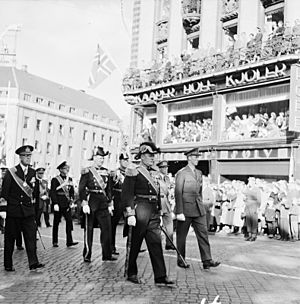
Haakon died at the Royal Palace in Oslo on 21 September 1957. He was 85 years old. After his death, Olav became Olav V. Haakon was buried on 1 October 1957. He rests next to his wife in the Royal Mausoleum. This is at Akershus Fortress. He was the last living son of King Frederick VIII of Denmark.
Haakon VII's Legacy
Many people see Haakon VII as one of Norway's greatest leaders before the war. He managed to keep his young country together during difficult times. He was highly ranked in the Norwegian of the Century poll in 2005.
Awards and Recognitions
The King Haakon VII Sea in East Antarctica is named after the king. The entire plateau around the South Pole was named King Haakon VII Vidde. This was done by Roald Amundsen in 1911. Amundsen was the first person to reach the South Pole.
In 1914, Haakon County in the American state of South Dakota was named in his honor.
Two Royal Norwegian Navy ships were named after King Haakon VII. They were King Haakon VII (an escort ship, 1942–1951) and Haakon VII (a training ship, 1958–1974).
For his fight against the Nazis and his efforts to restart the Holmenkollen ski festival after World War II, King Haakon VII received an award. He earned the Holmenkollen medal in 1955. He shared it with Hallgeir Brenden, Veikko Hakulinen, and Sverre Stenersen. He is one of only 11 people not famous for Nordic skiing to get this honor.
Military Honors
- Admiral of the Royal Danish Navy, from 20 November 1905.
- Honorary Admiral of the Royal Navy.
- Honorary Lieutenant in the Royal Navy, from 7 February 1901.
- Honorary Colonel of the Royal Artillery.
- Honorary Colonel of the Norfolk Yeomanry, from 11 June 1902 to 21 September 1957.
- Colonel-in-Chief, The Green Howards, from 12 May 1942 to 21 September 1957.
Norwegian Awards
- War Cross with Sword
- Gold Medal for Outstanding Civic Achievement
- Grand Master of the Order of St. Olav, from 18 November 1905
International Awards
 Denmark:
Denmark:
- Knight of the Elephant, 3 August 1890
- Cross of Honour of the Order of the Dannebrog, 3 August 1890
- Grand Commander of the Dannebrog, 28 July 1912
- King Christian X's Freedom Medal
 Belgium: Grand Cordon of the Order of Leopold (military), 2 October 1906
Belgium: Grand Cordon of the Order of Leopold (military), 2 October 1906 Brazil: Grand Cross of the Southern Cross, with Collar
Brazil: Grand Cross of the Southern Cross, with Collar Czechoslovakia:
Czechoslovakia:
- Grand Cross of the White Lion, 1937
- Czechoslovak War Cross 1939–1945
 Ethiopian Imperial Family: Collar of the Order of Solomon
Ethiopian Imperial Family: Collar of the Order of Solomon Finland: Grand Cross of the White Rose, with Collar, 1926
Finland: Grand Cross of the White Rose, with Collar, 1926 France:
France:
- Grand Cross of the Legion of Honour
- Cross of War (1939–1945)
- Médaille Militaire
 Greek Royal Family:
Greek Royal Family:
- War Cross, 1940
- Grand Cross of the Redeemer, 1947
 Iceland: Grand Cross of the Falcon, with Collar, 1955
Iceland: Grand Cross of the Falcon, with Collar, 1955 Italian Royal Family: Knight of the Annunciation, 12 April 1909
Italian Royal Family: Knight of the Annunciation, 12 April 1909 Japan: Collar of the Order of the Chrysanthemum
Japan: Collar of the Order of the Chrysanthemum German Imperial and Royal Family:
German Imperial and Royal Family:
- Knight of the Black Eagle
- Grand Cross of the Red Eagle
 Netherlands: Grand Cross of the Netherlands Lion
Netherlands: Grand Cross of the Netherlands Lion Peru: Grand Cross of the Sun of Peru, in Diamonds, 1922
Peru: Grand Cross of the Sun of Peru, in Diamonds, 1922 Poland: Knight of the White Eagle, 1930
Poland: Knight of the White Eagle, 1930 Portuguese Royal Family:
Portuguese Royal Family:
- Grand Cross of the Sash of the Three Orders
- Grand Cross of the Tower and Sword
 Romanian Royal Family: Grand Cross of the Order of Carol I, with Collar
Romanian Royal Family: Grand Cross of the Order of Carol I, with Collar Russian Imperial Family:
Russian Imperial Family:
- Knight of St. Andrew
- Knight of St. Alexander Nevsky
- Knight of the White Eagle
 Spain: Knight of the Golden Fleece, with Collar, 16 July 1910
Spain: Knight of the Golden Fleece, with Collar, 16 July 1910 Sweden: Knight of the Seraphim, 30 May 1893
Sweden: Knight of the Seraphim, 30 May 1893 Thailand: Knight of the Order of the Royal House of Chakri
Thailand: Knight of the Order of the Royal House of Chakri Turkish Imperial Family: Order of Osmanieh, 1st Class in Diamonds
Turkish Imperial Family: Order of Osmanieh, 1st Class in Diamonds United Kingdom:
United Kingdom:
- Honorary Grand Cross of the Bath (civil), 21 July 1896
- Honorary Grand Cross of the Royal Victorian Order, 2 February 1901
- Royal Victorian Chain, 9 August 1902
- Stranger Knight of the Garter, 9 November 1906
- Bailiff Grand Cross of St. John, 12 June 1926
- Queen Victoria Diamond Jubilee Medal
- King Edward VII Coronation Medal
- Honorary Citizen of Largs, Scotland
Images for kids
See also
 In Spanish: Haakon VII de Noruega para niños
In Spanish: Haakon VII de Noruega para niños
- List of state visits made by Haakon VII of Norway
- List of covers of Time magazine (1920s), (1930s)



